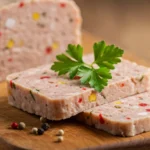Welcome, food explorers! If you’ve ever been curious about head cheese, you’re not alone. Despite the name, it’s not actually cheese—but rather a flavorful, traditional meat terrine made from the head of a pig or calf, cooked down into a rich, savory loaf. Don’t let the old-school roots fool you—head cheese is making a comeback with home cooks who appreciate rustic, no-waste cooking and bold, nostalgic flavors. Here at Recipes2Gather, we love sharing heritage recipes that bring people together, and head cheese is one of those dishes steeped in history, heart, and plenty of flavor.
Let’s take the mystery out of this classic and show you how to make head cheese that’s not only approachable, but absolutely delicious.
Key Benefits
There’s a reason head cheese has stood the test of time. While it may sound intimidating, it’s surprisingly easy to prepare, incredibly flavorful, and filled with benefits:
- Old-school flavor, modern methods: While the recipe dates back generations, today’s techniques make it much simpler to prepare.
- Zero waste cooking: This dish makes use of cuts often overlooked, honoring a tradition of sustainability and respect for the whole animal.
- As the meat and bones simmer low and slow, they release natural collagen and protein that come together into a smooth, jelly-like texture—what gives head cheese that classic, wobbly finish.
- Customizable flavor: Add herbs, garlic, peppers, or pickled vegetables to make each loaf uniquely your own.
This traditional approach is similar in spirit to our mastering hog head cheese post, which shows just how rewarding this process can be when done with care.
Ingredients for Head Cheese
Head cheese doesn’t take fancy ingredients—just good basics, time, and a bit of love:

- 1 pig’s head (split and cleaned) – meat, skin, and bone all contribute to flavor and structure
- 2–3 cloves garlic – for depth of flavor
- 1 onion, halved – aromatic base
- 1–2 bay leaves – adds earthiness
- Salt and pepper – to taste
- Fresh parsley or other herbs – chopped, for garnish and brightness
- Optional: diced bell peppers or pickles – for texture and zing
- Water – enough to cover the head while simmering
You’ll notice the simplicity echoes the approach we use in cottage cheese sauce for chicken: straightforward ingredients, big flavor.
Step-by-Step Instructions for Head Cheese
Here’s how to turn simple ingredients into something rich, savory, and sliceable:

- Clean and Simmer the Head
Thoroughly clean the pig’s head, removing any bristles. Set the cleaned head in a big pot, fill it with water to cover, and toss in onion, garlic, bay leaves, salt, and pepper for flavor. - Simmer Until Tender
Bring the pot to a boil, then lower the heat and let it gently bubble away until everything’s tender. Cook uncovered for 4–6 hours, or until meat easily pulls away from the bone. - Strain and Pick the Meat
Carefully lift the head out and give it a few minutes to cool before handling. Strain the broth and reserve. Pick all the usable meat, skin, and fat from the bones. Chop finely. - Season and Mix
Combine the chopped meat with optional ingredients like parsley, diced peppers, or vinegar. Stir in enough strained broth to bind everything together. - Mold and Chill
Pack the mixture tightly into loaf pans or molds. Pour in a bit more broth to cover the top. Chill overnight to set. - Slice and Serve
Once firm, turn out the head cheese, slice, and serve cold with mustard, crackers, or crusty bread.
This method is rooted in tradition, much like our old-fashioned pimento cheese recipe that highlights the charm of vintage recipes.
Pro Tips and Variations for Head Cheese
Let’s make this dish your own! Here’s how to tweak it for different flavor preferences and occasions:
- Use a pressure cooker: Save time by cooking the head under pressure—cuts the cook time in half.
- Brighten things up with a little vinegar or lemon juice—it cuts through the richness and adds a fresh kick.
- Swap the meat: Use calf’s head, pork hocks, or even turkey necks for a different protein spin.
- Include vegetables: Bell peppers, onions, or pickled carrots add color and crunch.
- Make mini molds: Use ramekins or muffin tins for individual portions—perfect for party platters.
You can enjoy this on a sandwich just like our cheeseburger bowl obsession, or slice it thin for a charcuterie board centerpiece.
Serving Suggestions for Head Cheese
Don’t let the name fool you—head cheese is surprisingly versatile and delicious when paired right. Looking for serving ideas? Here are some delicious ideas for how you can dig in:
- With crackers and mustard: The classic combo—rich head cheese meets tangy mustard and crispy crackers.
- On rustic bread: Add pickled onions or a swipe of aioli for a hearty open-faced sandwich.
- As part of a charcuterie board: Pair with sharp cheeses, olives, and crusty baguette slices.
- With hot sauce: A spicy kick balances the savory depth of the loaf.
- Southern-style snack: Serve cold with saltines, hot sauce, and a cold drink—just like grandma used to.
Pair this with other down-home dishes like our cottage cheese buffalo chicken dip for a rustic, crowd-pleasing spread.
Trasted Resources for Head Cheese
- Learn the roots of head cheese and its cultural variations in this deep dive from Smithsonian Magazine.
- Read why collagen-rich dishes like head cheese are gaining popularity at Healthline.
- USDA food safety tips for storing cooked meats like head cheese can be found here.
- Check out culinary uses and recipes at Bon Appétit.
Conclusion
Head cheese is one of those time-honored dishes that might sound unusual at first but delivers big on flavor and satisfaction. Once you’ve made it from scratch, you’ll understand why it has such a loyal following. It’s rich, hearty, and rooted in tradition—a true comfort food for those who appreciate real ingredients and classic cooking. At Recipes2Gather, we’re all about celebrating the recipes that connect generations, and this one certainly earns its place at the table. So go ahead, give it a shot—you might just fall in love with this savory classic.
Print
Head Cheese Recipe That’s Surprisingly Tasty and Easy
- Total Time: 6.5 hours
- Yield: 2 loaves
- Diet: Gluten Free
Description
This homemade head cheese is rich, flavorful, and surprisingly easy to make with simple ingredients and traditional methods. Perfect for rustic platters or snacks.
Ingredients
- 1 pig’s head, cleaned and split
- 1 onion, halved
- 2–3 garlic cloves
- 1–2 bay leaves
- Salt and pepper, to taste
- Fresh parsley, chopped
- Optional: diced bell peppers or pickles
- Water to cover
Instructions
- Clean the pig’s head and place in a large pot. Add onion, garlic, bay leaves, salt, and pepper.
- Cover with water and bring to a boil. Reduce to a simmer and cook uncovered for 4–6 hours.
- Remove head, cool slightly, and pick the meat from bones. Chop finely.
- Strain the broth and mix with chopped meat and add-ins.
- Pack into loaf pans, cover with broth, and chill overnight until set.
- Slice and serve cold with mustard or bread.
Notes
Use pork hocks or trotters as an alternative to a full pig’s head.
- Prep Time: 30 minutes
- Cook Time: 6 hours
- Category: Appetizer
- Method: Simmering
- Cuisine: American
FAQs
Is head cheese really made from cheese?
Nope! Despite the name, there’s no cheese involved—just a mix of slow-cooked meat and broth that sets like a terrine.
Wondering how long head cheese keeps in the fridge?
Stored tightly wrapped, it’ll keep for up to 5 days in the refrigerator.
Can I freeze head cheese?
Absolutely! Just tuck it into an airtight container and freeze it—it’ll hold up for about three months. The texture might be a bit softer once it’s thawed, but still tasty.
Not a fan of using the whole head?
Not at all—you can use pork hocks, trotters, or other gelatin-rich cuts to create a similar effect.


1 thought on “Head Cheese Recipe That’s Surprisingly Tasty and Easy”